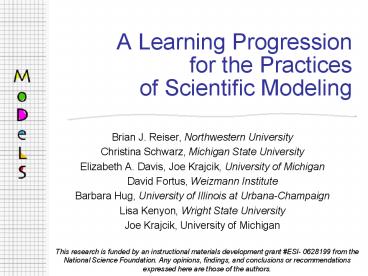A Learning Progression for the Practices of Scientific Modeling - PowerPoint PPT Presentation
1 / 17
Title:
A Learning Progression for the Practices of Scientific Modeling
Description:
Christina Schwarz, Michigan State University ... So we would always do more experiments and stuff to help us add or learn new things to a model. ... – PowerPoint PPT presentation
Number of Views:67
Avg rating:3.0/5.0
Title: A Learning Progression for the Practices of Scientific Modeling
1
A Learning Progression for the Practices of
Scientific Modeling
- Brian J. Reiser, Northwestern University
- Christina Schwarz, Michigan State University
- Elizabeth A. Davis, Joe Krajcik, University of
Michigan - David Fortus, Weizmann Institute
- Barbara Hug, University of Illinois at
Urbana-Champaign - Lisa Kenyon, Wright State University
- Joe Krajcik, University of Michigan
This research is funded by an instructional
materials development grant ESI- 0628199 from
the National Science Foundation. Any opinions,
findings, and conclusions or recommendations
expressed here are those of the authors.
2
Why a Learning Progression Around a Scientific
Practice?
- Practices represent disciplinary norms for how
knowledge is constructed, evaluated and
communicated. - Important for understanding how knowledge is
built in science, and for helping learners
develop and use scientific understandings. - Practices are challenging what aspects of
scientific practice are productive to bring into
science classrooms?
3
Scientific Modeling
4
Two Main Dimensions of the Learning Progression
- Models are generative tools for prediction and
explanation - Well, it kind of explains and shows you what is
actually in the air. Instead of just saying, Oh,
theres empty space there, theyll be like,
What do you mean? So if you have a model, you
can actually show them, and it might explain it
better. - Models are dynamic and are subject to change as
our understanding improves - I think there can be a right model, but in our
class, I dont think anybodys had the perfect
model yet because some people came really close
to having a good model, but there was always
something that was missing in it. So we would
always do more experiments and stuff to help us
add or learn new things to a model.
5
Models as Tools for Generating Knowledge
6
From literal to mechanistic models
Pretest
Increase in invisible objects (particles),
arrows, wavy lines, time changes, scale, and
processes
(Gen L2)
(Gen L1)
Posttest
7
Using model to explain new phenomena
(Gen L3)
8
Models as Changeable Entities
9
Evaluting/Revising Models
- Fred ..sunlight goes into the water and
evaporates into the air. - Jack It doesnt evaporate into the air
- Chris And you think yours model is better
why? - Scott His says more
- Fred His says more, but it is wrong
- Scott Jack get to the point, it is just the
water thing, we are not really studying the
water thing. on our final thing model we are
not going to show that water actually goes into
the ground cause we are studying on evaporation
and not how it goes in the ground. (Change L3)
10
Changing Models
- Why would you decide to change your model? (5th
grade Interview) - Pre If you don't have the right calculations,
that kind of stuff. (Change L1) - Post Well, my models change by me thinking that
water just went somewhere to knowing that water
evaporates into the sky. It can change by adding
more detailand making sure that it's easy and
understandable. (Change L2)
11
Comparing Models
- Comparing models (6th grade interview)The thing
about the model on the right, its only showing
one thing in the flask. Its just showing the
carbon dioxide, but in this model, its showing
more of everything thats in the air Its
showing how they are connected and how each
molecule is made up of different things. (Change
L3)
12
What are we learning
- Design approach for weaving metaknowledge and
practice - Which aspects of metaknowledge have real utility
in getting the job done? - Q How general is what is learned?
- Q Do types of models entail different kinds of
performances understanding? - Mechanistic physical model of process
- structural models
- dynamic computational and physical models that
behave
13
(No Transcript)
14
Why the Practice of Modeling?
- The key role of science is building explanations
about how the world works models - Models mediate empirical data and patterns with
theories and explanations - Models can scaffold communication and facilitate
classroom discourse - Modeling can help learners build
- subject matter understanding
- epistemological understanding
- practices and skills (e.g. systems thinking)
15
What is a Scientific Model?
- A Scientific Model
- a representation that abstracts and simplifies a
system to make its central features explicit - It consists of elements, relations, operations,
and rules governing interactions that are
expressed using external notation systems. (Lesh
Doerr, 2000) - internal and expressed models (Gobert
Buckley,2000) - can be used to generate predictions and
explanations for natural phenomena
16
Models as Generative Tools
17
Use and Applying Models
- Students drew explicitly on models in
constructing explanations for phenomena and
extrapolating to new phenomena
In the model of the cup with no lid, the water
is evaporating into water vapor or gas, and
thats what happens with the marker because its
a liquid and all liquids evaporate into a gas or
water vapor.































